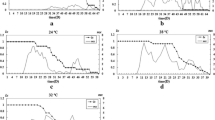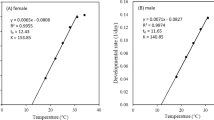Abstract
Development, survival, fecundity, progeny sex ratio (PSR) and age-specific life-table parameters of the parasitoid Campoletis chlorideae Uchida (Hymenoptera: Ichneumonidae) were examined at six different constant temperatures (12, 17, 22, 27, 32 and 37°C) in the laboratory [70 ± 10% RH and 10:14 h (light:dark) photoperiod]. Second instar larvae of Helicoverpa armigera (Hübner) (Lepidoptera: Noctuidae) were reared on chickpea (Cicer arietinum L.) and used as the host. Development times shortened as the temperature increased from 12 to 37°C. The estimated lower developmental threshold (tL) was 3.4°C. The thermal summation for total immature stages was 379.97 degree-days. A reciprocal relationship between temperature and longevity was observed in the range of 12–17°C. The maximum mortality of pupae (71.8%) occurred at 37°C. At 22°C, the yield of a female parasitoid averaged 137.3 ± 14.7 (mean ± SD) progeny, of which 89.6 ± 7.6 were daughters. The number of daughters produced decreased when the females were kept either above or below 22°C, although the PSR was female biased in the range of 17–27°C. The analyses of life-table parameters, developmental rates, reproduction, mortality and PSR suggest that maximum population growth (r m ) is near 27°C. There was little variation observed in most of the desired qualities of C. chlorideae in the range of 17–27°C, and it appears that the parasitoid is adapted to a wide range of temperatures. We suggest that for maximum production the parasitoid should be reared at 22 ± 4°C and be released in areas where the temperature ranges between 17° and 27°C, as in the plains of northern India.





Similar content being viewed by others
References
Ahmed KN, Khan AR (1995) Biological note on Campoletis chlorideae Uchida (Hymenoptera: Ichneumonidae). Bangladesh J Zool 6:243–244
Andrewartha HG, Birch LC (1955) The distribution and abundance of animals. The University of Chicago Press, Chicago
Bernal J, Gonzalez D (1993) Temperature requirements of four parasites of the Russian wheat aphid Diuraphis noxia. Entomol Exp Appl 69:173–182
Birch LC (1948) The intrinsic rate of natural increase of an insect population. J Anim Ecol 17:15–26
Butler GD Jr, Lopez JD (1980) Trichogramma pretiosum: Development in two hosts in relation to constant and fluctuating temperatures. Ann Entomol Soc Am 73:671–673
Campbell A, Frazer BD, Gilbert N, Gutierrez AP, Mackauer M (1974) Temperature requirements of some aphids and their parasites. J App Ecol 11:431–438
Chihrane J, Laugé G, Hawlitzky N (1993) Effects of high temperature shocks on the development and biology of Trichogramma brassicae (Hym.: Trichogrammatidae). Entomophaga 38:185–192
Dai XF (1990) Biology of Campoletis chlorideae (Hymenoptera: Ichneumonidae) and its control of Cotton bollworm in the field. Chinese J Biol Con 6:153–156
Durairaj C (1999) Integrated management for pigeon pea pod borer complex. Ann Rev Pestol Special Issue, February 1999
Force DC, Messenger PS (1964) Fecundity, reproductive rates and innate capacity of increase of three parasites of Therioaphis maculata (Buckton). Ecology 45:706–715
Hoelscher CE, Vinson SB (1971) The sex ratio of hymenopteran parasitoid, Campoletis perdistinctus, as affected by photoperiod, mating and temperature. Ann Entomol Soc Am 64:1373–1376
Kaur S, Brar KS, Sekhon BS, Joshi N, Shenhmar M, Singh J (2000) Role played by Campoletis chlorideae Uchida in Natural mortality of Helicoverpa armigera on chickpea in Punjab. J Biol Control 14:51–54
Kaushal P, Chauhan U, Kumar SP (1999) Natural enemies of bud borer Helicoverpa armigera (Hübner) in carnation. Inst Environ 52–53
Kumar N, Kumar A, Tripathi CPM (1994) Functional response of Campoletis chloridae (Hymenoptera: Ichneumonidae), a parasitoid of Heliothis armigera (Hübner) (Lepidoptera: Noctuidae) in an enclosed experimental system. Biol Agric Hortic 10:287–295
Kumar N, Kumar A, Tripathi CPM (2000) Sex ratio of Campoletis chlorideae uchida in response to Heliocoverpa armigera (Hübner) density. Inst Sci Appl 20:73–76
Messenger PS (1964) Use of life-tables in a bioclimatic study of on experimental aphid braconid wasp host-parasite system. Ecology 45:119–131
Nandihali BS (1994) Ecology of an egg parasitoid Trichogramma chilonis Ishii and a larval parasitoid Campoletis chlorideae Uchida, of the oriental tobacco bud worm, Helicoverpa assulta (Guenee). PhD thesis, Seoul National University, Seoul, Korea
Nikam PK, Basarkar CD (1978) Studies on the effect of temperature on the development of Campoletis chlorideae Uchida (Hymenoptera: Ichneumonidae) an internal larval parasite of Heliothis armigera (Hubn.). Entomon 3:307–308
Pandey P, Kumar N, Tripathi CPM (2004) Impact of males on the sex ratio of Campoletis chlorideae Uchida (Hym., Ichneumonidae), a parasitoid of Helicoverpa armigera (Hübner) (Lep., Noctuidae). J Appl Entomol 128:254–256
Pandey S, Singh R (1998) Effect of temperature on the development and reproduction of a cereal aphid parasitoid Lysiphlebia mirzai Shuja-Uddin (Hym.: Braconidae). Biol Agric Hortic 16:239–250
Patel AG, Yadav DN, Patel RC (1988) Effect of low temperature storage on Campoletis chloridae Uchida (Hymenoptera: Ichneumonidae), an important endolarval parasite of Heliothis armigera (Hübner) (Lepidoptera: Noctuidae). Gujarat Agric Univ Res J 14:79–80
Raju GT, Biradar AP, Balikai RA, Rao KJ (2001) Effect of temperature, relative humidity and their interactions on the development of Campoletis chlorideae Uchida. Adv Agric Res India XVI:49–53
Singh R, Pandey S, Singh A (2000) Effect of temperature and photoperiod on development, fecundity, progeny sex ratio and life-table of an aphid parasitoid Binodoxys indicus. Malay J Appl Biol 29:79–95
Srinivas PR (1989) Extent of parasitism of gram pod borer Heliothis armigera by Ichneumonid larval parasites. Indian J Agric Sc 59:377–378
van Steenis MJ (1994) Intrinsic rate of increase of Lysiphlebus testaceipes Cresson (Hymenoptera: Braconidae), a parasitoid of Aphis gossypii Glover. J Appl Ent 118:399–404
Waage JK (1986) Family planning in parasitoids: adaptive patterns of progeny and sex allocation. In: Waage JK, Greathead DJ (eds) Insect parasitoids. Academic Press, London, pp 63–95
Acknowledgements
The first author (Amarendra K. Pandey) is grateful to CSIR, New Delhi, India for providing financial assistance by awarding a Research Fellowship (Award No. 9/57 (170)/2K3-EMR-I).
Author information
Authors and Affiliations
Corresponding author
Rights and permissions
About this article
Cite this article
Amarendra K. Pandey, Tripathi, C.P.M. Effect of temperature on the development, fecundity, progeny sex ratio and life-table of Campoletis chlorideae, an endolarval parasitoid of the pod borer, Helicoverpa armigera . BioControl 53, 461–471 (2008). https://doi.org/10.1007/s10526-007-9083-3
Received:
Accepted:
Published:
Issue Date:
DOI: https://doi.org/10.1007/s10526-007-9083-3




